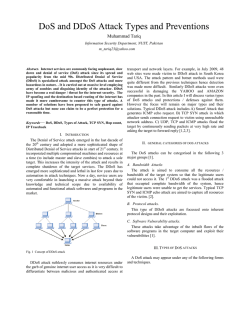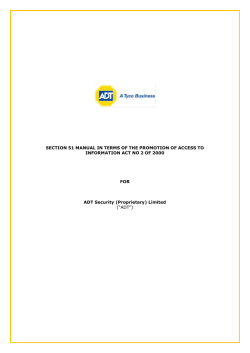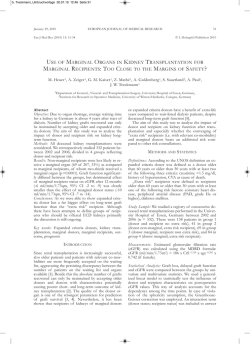
Viagra Apteka Szczecin — Good Prices, Wide Choice Of Medications
An Investigative Study on Modeling a
DDoS Attack and Defense Measure in OPNET
Shahid Akhter, Christopher Bowen, Jack Myers, Dr. Vasil Hnatyshin
Abstract. Distributed Denial of Service (DDoS) attacks continue to plague today's Internet. The variety and ingenuity of such attacks
requires network security analysts to perpetually develop more robust forms of attack identification and prevention. OPNET modeling is a
powerful tool to model not only the DDoS attacks themselves, but also the preventative measures. OPNET offers heavy-duty simulation
capabilities to model a nearly unlimited number of network permutations, such as variations in network protocols, addressing and topology.
Introducing OPNET into the arsenal of tools to harden modern networks is a valuable contribution to network analysis. This paper leverages
OPNET to model one particular attack and defense.
1. Introduction
In the middle of our examination on distributed denial of
service (DDoS) attacks, the world's 76th most visited
website was brought down by one such attack. The
Swedish website Pirate Bay, also the 74th most visited in
the United States, and the 15th most visited in Sweden [1],
is one of the world's most popular BitTorrent sites. Often
criticized and reviled for promoting copyright
infringements, the site also provides a peer-to-peer outlet
for legal distribution of works from filmmakers, musicians,
artists and writers. Over ten thousand independent artists
have signed up with Pirate Bay in hopes of breaking
through to a global audience [2]. Pirate Bay is associated
with several private BitTorrent trackers which are
designed to be selective in order to make sure members
have a community-friendly upload to download ratio. The
site was taken out of service on 14 November 2012 via a
DDoS attack, when a disgruntled user was not admitted to
a private tracker [3].
2.1 Exploiting application vulnerabilities
An example of a DDoS attack specifically designed to
exploit an application vulnerability is an attack targeted at
Apache web servers.
This DDoS attack works by flooding an Apache web server
with so much data that it locks up and can no longer serve
web pages. Apache web servers, like most other web
servers, enable a feature that allows a user to pause and
resume HTTP downloads of large files. The Apache web
server application is particularly vulnerable when
hundreds of very large overlapping parts of a file are
requested in a single request [4]. Attacks that exploit this
vulnerability will crash an application running on the
server, rather than the server itself.
2.2 Exploiting network nodes
Even though DDoS attacks are nothing new so far as the
Internet is concerned, they are still causing site outages to
this day. This paper is focused on using OPNET as a tool
to model DDoS attacks, their detection and prevention, in
the hopes that establishing such models will further
facilitate more resiliency in today's Internet.
.
DDoS attacks that cause network nodes to fail are
becoming more prevalent due to the rise in the number
and importance of wireless networks.
Wireless communications are always vulnerable to
interference. One well known example is the interference
created between Microsoft's Xbox and the 802.11n
wireless network. The Xbox emits wireless signals using
the 2.4 GHz band, which is also employed by 802.11n
(although 802.11n can also use a 5 GHz band).
2. Attack Types (SYN Flood)
DDoS attacks can be categorized based on the target of the
attack, specifically:
the resources of the target, or
the link which connects the target to the Internet.
This type of wireless interference can also be created using
frequency jammers. Frequency jammers are legally used
an application vulnerability,
network nodes,
1
outside the United States. In France, they are used to block
cell phone transmissions in theatres or restaurants; in Italy
they are used in examination rooms to reduce the
likelihood of academic dishonesty. Mexico uses them to
preserve the sanctity of religious services.
Miniature
jammers can be used in a distributed network for the
purpose of intentional and malicious disruption of wireless
networks.
zombie via its source IP address.
A better form of attack would be to spoof the IP address of
an "innocent" end node, causing the targeted server to
send a SYN-ACK to these spoofed addresses. The nodes
that now receive the SYN-ACK from the server are either
not in the SYN_SENT state or in that state with a different
destination IP address. In either case, the innocent nodes
will disregard the SYN-ACK and will not respond to the
targeted server. Thus the targeted server will keep the
connection open until the timeout expires – waiting for an
ACK that will never come. These half-open connections
consume resources on the targeted server. If enough of
these connections are established, the server's resources
could be exhausted, thereby blocking additional
connections from occurring.
Tiny, low power jammers – microelectromechanical
systems (MEMS) using nanotechnology – can be built so
small that they can be distributed in the air as "dust,"
forming a distributed jammer network. As jammers have a
smaller function compared to sensors, (emitting noise
signals, versus performing complex modulation, filtering
and other signal processing functions) they can be
miniaturized more easily. The United States employed
such techniques in the second Gulf War in Iraq [5].
The attack can be further enhanced by generating random
IP addresses, avoiding the suspicious behavior of an
innocent node repeatedly requesting a large number of
connections.
2.3 Exploiting the resources of the target
A SYN flood DDoS attack occurs when several zombies
send multiple, rapidly repeated TCP SYN requests to the
targeted server but do not acknowledge the SYN
transmission. Such attacks will force the attacked node to
maintain an excessive number of half-open TCP
connections, which will eventually consume all of the
available server resources and crash the node. This was
the form of attack that was used to take Pirate Bay out of
service in November 2012.
If the zombies never
acknowledge the SYN request, the server will keep open
the connection until a time-out occurs. However, this form
of attack has the distinct disadvantage of identifying the
2.4 Exploiting the link connecting the target to the Internet.
Another form of DDoS attack focuses neither on the target
end-node, the applications running on the node, nor the
network devices the target relies on, but rather on the
target's connection itself. This can be accomplished by
flooding the network channels with so much traffic that
the target effectively has no available bandwidth for its
own legitimate Internet requests.
This type of attack can essentially be considered a hybrid
attack with multiple victims. The first victim is the client
whose bandwidth is being targeted as described earlier in
this section. The second victim is the server which would
suffer from the degradation of its resources as it is
commandeered to send illegitimate traffic.
The UDP transport protocol is well suited for such attacks
because it transmits unthrottled traffic. UDP flooding can
be accomplished particularly well with high definition
video streaming.
2.5 Selection of a DDoS Attack Mode
DDoS attacks focusing on particular application
vulnerabilities would be difficult if not impossible to model
in OPNET. These types of attacks are best modeled in a lab
scenario where actual servers are equipped with the
vulnerable applications. Hence this type of attack was not
selected for OPNET modeling.
Attacks on network nodes, especially ones similar to
distributed jamming of wireless nodes, would be
Figure 2-1. A TCP SYN attack
2
challenging to model in OPNET. Such models would
require simulation of routers being disrupted by powerful
rogue signals. Such attacks were also dismissed as not
being good candidates for OPNET simulations.
The packet filtering method requires the defending node
to build a clustered address map that correlates the
address of a node to the expected hop count. When
receiving traffic from a zombie with spoofed packets, the
server can compute the packets’ actual hop counts and
compare the values with the expected hop count. If these
values differ, the packet is associated with an attack and is
therefore discarded.
The TCP-based attacks leaving the targeted server with too
many half-open connections was appealing to model,
especially given the recent successful attack on Pirate Bay.
In fact, we initially attempted to simulate this model. We
quickly discovered that while the complexities of TCP
made this a most interesting study, it also presented a
more complex model to implement. As our goal was to
introduce DDoS modeling techniques in OPNET, we opted
for the UDP-based flooding attacks as described above.
4. Simulation Description
4.1 Node descriptions
In order to successfully mirror a DDoS attack in OPNET,
the following nodes have been created.
3. Defending Against Attacks Using Hop Count
The Innocent Recipient is the end-node that
will be the victim in our simulation. It will
not be requesting any video from the Video
Server Farm.
To defend against spoofed traffic, the targeted server must
discriminately respond to requests as shown in the figure
below.
There are three zombies (Zombie 1,
Zombie 2, and Zombie 3) in the
simulation. These zombie nodes
have been pressed into service of
the mastermind behind the DDoS
attack – likely through some
deficiency
in
their
security
configurations. The Zombie nodes
will request a service from the
server farm with a spoofed source
address so that the traffic would instead be redirected to
the victim, the Innocent Recipient.
The Video Server Farm houses nodes 2, 3, and 4.
Each node provides a video conferencing
service. These nodes will be manipulated by the
zombies into attacking the Innocent Recipient.
Originally, our intent was to compromise a
single node which would host a high resolution
video conference application. However, in order
to create enough traffic to overwhelm the
Innocent Recipient’s link, we needed to create
additional nodes in the farm.
Figure 3-1. Desired behavior of targeted server
The server must be able to determine whether to send a
response, and only send it when it ascertains the source is
legitimate. The increasingly popular field of research that
delves into detecting and defending against such attacks
has spawned a plethora of acceptable solutions.
The Legitimate Requester is the end-node
which will legitimately request low resolution
video provided by node 2 in the Video Server
Farm. The existence of a legitimate endsystem is important to ensure well-behaving nodes will
not be filtered out when running defensive measures
against DDoS attacks.
Proposed by Jin et. al., Hop-Count filtering is a technique
which utilizes hop counts derived from the IP header of a
packet [6]. Upon creation of an IP packet, the time-to-live
(TTL) field will hold the maximum lifetime of the packet
which gets decremented by each node that forwards it.
The difference between the initial TTL and the TTL at the
destination is computed to be the hop count.
Standard network routing devices have been
added to our model, retaining their OPNET
3
default values. These routers simply forward packets along
to their destination.
}
This code checks to see if the IP parameter spoofIP is true.
If the initiating node has spoofIP ON, the IP address of the
victim (Innocent Recipient) will be stored in the “src_addr”
header field in the IP datagram. Note that we leveraged
the OPNET function inet_address_create which will build
an IPv4 address (paramenter two) for the string
containing the IPv4 address of the victim (parameter one).
A subnet was created as a collection of router
nodes A-Z with different entry points. The
Legitimate Requester will enter the subnet at
entry point J; zombies will enter at entry point A, and the
Innocent Recipient will enter at entry point U.
The depiction of all nodes is shown in Figures 4-1 and 4-2.
4.4 Simulating knowledge of hop counts
4.2 OPNET Applications
Our selected defense against a DDoS attack with a spoofed
address relies on knowledge of the actual hop counts one
would expect from the source to the destination. As
mentioned previously, the IP parameter time-to-live (TTL)
is directly related to the hop count. In reality, a
mechanism would exist to store and/or dynamically obtain
the hop counts for each requester.
In order to completely consume the link between the
Innocent Recipient and its edge router, we needed to create
applications that would send a large amount of traffic. In
order to simplify the OPNET model, we selected the Video
Conferencing application, as it would send a large amount
of UDP traffic which would be unaffected by TCP flow and
congestion control.
Source Node
Application
Zombie 1
Zombie 2
Zombie 3
Legitimate
Requester
SpoofIP_Video3
SpoofIP_Video
SpoofIP_Video2
Destination
Video Server
node 4
node 2
node 3
LegitIP_Video
node 2
To simulate this knowledge, we ran our simulation where
each zombie issued a request to the server farm with
spoofIP set to OFF. The Legitimate Requester also issued a
request for low resolution video traffic. The simulation
was run again, replacing the Innocent Recipient for the
Legitimate Requester.
Note that it was critical that each server in our video
server farm was connected to the subnet through the exact
same number of routers. In this way, the TTLs would not
vary across node2, node3 and node4.
Table 4-1. Deployed applications in the simulation
The three variations of SpoofIP_Video are configured to
conduct a high resolution video conference; the
LegitIP_Video application will initiate a low resolution
video conference.
While running all this legitimate traffic in the network, we
activated additional code in the decapsulation process of
ip_encap_v4.
4.3 SpoofIP parameter
/* Declare vars to capture information on IP datagrams */
char my_src_addr_str[INETC_ADDR_STR_LEN];
char my_dest_addr_str[INETC_ADDR_STR_LEN];
FILE *fp;
Within OPNET, it is possible to create an additional
parameter for each node. We created a spoofIP parameter
to differentiate between a normal mode of operations
which sends UDP traffic legitimately (IP header contains
the correct IP address for the sender), and a “zombie”
mode of operation in which the source address in the
header is changed to that of the victim. The new
parameter, spoofIP, can be toggled between ON (spoofing
enabled) and OFF (spoofing disabled).
/* Open a file to record data in CSV format */
fp = fopen("C:\\Users\\Jack\\DDoSResults.csv", "a");
if(fp == NULL)
fp = fopen("C:\\Users\\Jack\\DDoSResults.csv", "w");
fprintf(fp, "%s, %d, %s\n",
inet_address_print (my_src_addr_str,
ip_dgram_fd_ptr->src_addr),
ip_dgram_fd_ptr->ttl,
inet_address_print (my_dest_addr_str,
ip_dgram_fd_ptr->dest_addr));
fclose(fp);
To simulate what a zombie would do in the real world, we
adjusted the behavior of IP encapsulation in OPNET. By
adding the following code to the ip_encap_v4 process
model within OPNET, we are able manually change the
source address to that of the Innocent Recipient.
Whenever IP decapsulates, we record three values from
the IP datagram header: the source IP address, the TTL,
and the destination IP address.
if (spoofIP) {
ip_dgram_fd_ptr->src_addr = inet_address_create
("192.0.66.2", InetC_Addr_Family_v4);
With this information, we were able to definitively know
4
Figure 4-1. Network Topology
Figure 4-2. Subnet Topology
5
the actual TTLs for the requesting nodes, as seen in the
table below.
Source Node
Zombie 1
Zombie 2
Zombie 3
Legitimate Requester
Innocent Recipient
if (packet_spoofed) {
printf("\nPacket Dropped.\n");
packet_spoofed=0; // Reset to default.
}
else {
/* Install the ICI and send the packet to the
higher layer.
*/
op_ici_install (transp_iciptr);
op_pk_send (pkptr, output_strm);
}
TTL
23
21
22
27
28
Table 4-2. Actual TTLs for nodes in the simulation
The original code (marked in red font) was placed inside of
a conditional, such that it only executed when a spoofed
packet was not detected. Otherwise, we printed a message
to OPNET’s simulation console and reset the Boolean back
to the default.
4.5 Modifying the IP protocol for DDoS defense
The next addition to the simulation is to code the defensive
measure. We again utilized the IP decapsulation process of
ip_encap_v4 to model our defense.
5. Analysis/Results
Firstly, we created two new Boolean variables to record
various states of the simulation.
The variable
packet_spoofed will be set to TRUE (1) when the defensive
measure detects traffic with a spoofed IP address. The
variable defense_on will be toggled between zero and one
depending on whether the simulation is running with the
hop count defense. (If time had permitted, we would have
promoted this as an OPNET parameter.)
5.1 Spoofing with Vulnerable Server Farm
Using the spoofIP parameter, it is now possible to enable
spoofing for the zombie nodes and analyze the data
collected in the scenario.
In the simulation of the network with vulnerability, several
outcomes will be expected if the model was configured
correctly:
Boolean packet_spoofed=0;
Boolean defense_on=0;
the Legitimate Requester should receive only the data
it is requesting;
the amount of data that is received by the Innocent
Recipient and Legitimate Requester should closely
resemble the amount of data sent by the server farm;
the zombies should not receive any traffic despite
requesting traffic.
The code below would be activated in defensive mode.
if (defense_on) {
if (strcmp(inet_address_print (my_src_addr_str,
ip_dgram_fd_ptr->src_addr),"192.0.66.2")==0) {
// Coming from Innocent Recipient, may be spoofed
if (ip_dgram_fd_ptr->ttl != 28) {
// Discard the IP packet.
packet_spoofed=1;
}
}
if (strcmp(inet_address_print (my_src_addr_str,
ip_dgram_fd_ptr->src_addr),"192.0.6.1")==0) {
// Coming from Legitimate Recipient, may be spoofed
if (ip_dgram_fd_ptr->ttl != 27) {
// Discard the IP packet.
packet_spoofed=1;
}
}
}
It is important to first verify these expectations by
inspecting different graphs that help to solidify the
expected results.
The Legitimate Requester issues a request for a video
conference with the server farm.
Observe that the data obtained in section 4.4 is hard coded
into the if statements. If the TTL is not the expected value,
the packet needs to be dropped, so no UDP response will
be generated.
Elsewhere in the code, we react to the Boolean value
packet_spoofed.
Figure 5-1. Traffic received by the server farm.
6
Figure 5-4. Traffic received by the Innocent Recipient
Vs. Legitimate Requester Vs. the Server Farm.
Figure 5-2. Traffic sent by zombie nodes
Figure 5-1 above verifies that only the traffic sent by the
Legitimate Requester is being received – in this case, by
node_2. When node_2 receives the request for a video
conference, it responds as expected and a video conference
is initiated between the two nodes. It can also be noted
that the other two server nodes receive no traffic during
this simulation. Since the Innocent Recipient did not
initiate any requests, when the server nodes receive the
request from the spoofed zombies (the initial request can
be seen in Figure 5-2) and they try to begin video
conferencing, the Innocent Recipient will not send any
traffic back.
As it can be seen in Figure 5-3, the total number of packets
sent by the server farm is greater than the traffic actually
received by the Innocent Recipient and the Legitimate
Requester combined. It is our hypothesis that this is
caused by the simulation ending before the packets
actually get received (which will be further clarified when
queuing delay is discussed). However, it can be observed
that the actual amount of data received by the Innocent
Recipient far exceeds what was sent by any individual
server in the farm (Figure 5-4).
Arguably, the most important piece of data in this
simulation is the link utilization to the Innocent Recipient
from its edge router. This is the crucial element of the
DDoS simulation. If the simulated attack was successful,
the link utilization should be much higher than normal
(optimally 100%) due to the traffic flow from the zombie
requests.
To further validate the setup of this scenario, it is helpful
to look at traffic that is received by the Innocent Recipient
and the Legitimate Requestor in comparison to the traffic
that is sent by the server farms, as can be seen in the
following graphs. The zombies are spoofing their source
IP address to be that of the Innocent Recipient’s; therefore
all traffic initiated by the zombies should be sent to the
Innocent Recipient.
Figure 5-5. Link utilization connecting to the client
and zombie nodes from their respective edge routers.
Figure 5-3. Total traffic received by Innocent Recipient
and Legitimate Requester combined compared to
traffic sent by all servers in the Server Farm.
7
So as we have seen, the zombies are now able to spoof
source IP addresses and catastrophically effect the
network. Not only is the link utilization for the Innocent
Recipient directly affected, but the entire network begins
to see the increase of queuing delay. All of the initial
expectations of this experiment were verified in this
simulation.
5.2 Spoofing with a Defended Server Farm
By implementing Hop-Count filtering, it is possible to
prevent the calamitous consumption of the link as
discussed in section 5.1.
This defense mechanism,
implemented as described in section 4.5, would prevent
packets from being transmitted by the server farm to the
Innocent Recipient. This would eliminate, not only the
collapse of the Innocent Recipient’s link, but also the large
queuing delay throughout the network.
Figure 5-6. Link utilization from client nodes to their
respective edge routers.
In Figure 5-5, the zombie nodes all have a link utilization of
zero. This is expected because no data will be transmitted
back to them after they send their initial request with a
spoofed IP address. The Legitimate Requester (the red line
in Figure 5-5) does have some link utilization due to the
video conference occurring between it and the server
farm. The link from router_0 to the Innocent Recipient,
however, is highly utilized as was expected. Even though
the Innocent Recipient is never sending any traffic, it has
the most utilized link. This is caused by the amount of
traffic that is being transmitted from the server nodes as
requested by the three zombies.
Figure 5-8. Traffic received by the server farm in a
defended scenario.
Figure 5-7. Average queuing delay to the edge routers
from the subnets.
Since the utilization for the Innocent Recipient is so high
(Figure 5-5), it actually has a negative effect on the entire
network. As the link utilization for the Innocent Recipient
rises, the queuing delay for its respective edge router will
also grow. This results in a domino effect that will be
manifested as increased queuing delay across all network
paths that carry the UDP traffic to the Innocent Recipient.
This effect can be confirmed by examining the queuing
delay experienced by the Legitimate Requester. The delay
for both the Innocent Recipient and the Legitimate
Requester is almost equivalent.
Figure 5-9. Traffic sent by the zombies in a defended
scenario.
As seen in section 5.1, when the defensive measure was
applied, there was no deviation in the UDP traffic received
by the server farm and the UDP traffic sent by the zombies
(Figure 5-8 and 5-9 respectively). However, the amount of
8
traffic sent by the server has significantly decreased
(Figure 5-10). The only traffic actually being sent by the
server farm is the traffic that was requested by the
Legitimate Requester. The server farm detects a difference
in the expected hop count and never sends traffic to the
Innocent Recipient.
edge router is now “normalized” to that of the edge routers
for the zombie nodes. The only prevalent queuing delay is
now experienced by the Legitimate Requester’s edge
router, since it is the only node sending and receiving data.
Figure 5-12. Average queuing delay between edge
router and subnet (both directions).
Figure 5-10. Traffic sent by the server farm in a
defended scenario.
By implementing a defensive mechanism, (in this case
Hop-Count filtering), it is possible to prevent a DDoS attack
over UDP. This defense not only protects the Innocent
Recipient by reducing link utilization and queuing delay,
but also reduces the strain on the resources of the server
farm.
6. Conclusion
In conclusion, we have demonstrated the ease at which a
DDoS attack and defense can be modeled in OPNET. This
research acts as a springboard into further refinements of
the selected model as well as paving the way for future
expansions into other forms of attack and defense.
Figure 5-11. Link utilization for the clients and
zombies from their respective edge routers.
7. Future Work
Some improvements can be made to the OPNET DDoS
defense/attack model used in this paper. It would be wise
to promote the defense_mode variable to a parameter
which can be toggled as was done for spoofIP.
This can be further verified by inspecting the link
utilization to the Innocent Recipient from its edge router.
In the previous simulation, we saw that link was highly
utilized when the defense was disabled. When enabled,
the utilization of this link is now close to zero, indicating
the success of the defense mechanism. The utilization for
the Legitimate Requester (the red line in Figure 5-11) now
becomes the highest value in the simulation.
In the actual Hop-Count filtering defense, a table which
correlates an IP address to its hop count is utilized. As
described in section 4, we hard coded these values for
simplicity. The next step in improving the model would be
to implement a hash table which would contain these
values so that actual lookup of hop count can occur.
As expected, the noticeable decrease in link utilization for
the Innocent Recipient also has a major impact on the
queuing delay between the Innocent Recipient’s edge
router and the subnet in both directions.
When a packet is detected as part of an attack, our current
implementation ignores the packet but only reports this
packet loss in the simulation console. A more elegant
The queuing delay experienced by the Innocent Recipient’s
9
alternative to this is to update OPNET’s packet drop
statistic to enable comparison of the capabilities of
different defensive measures.
send response
In order to simulate this in OPNET, the IP process model
must be altered to allow for a packet identification field.
To utilize this, a node model must be altered so that it
marks its last n bits into the packet identification field.
Once complete, a similar simulation can be created as
mentioned in Section 4 to verify the correctness of the
proposed combined defensive measure.
Although Hop-Count filtering provides a light-weight and
effective method in defending against DDoS attacks, it
could potentially be improved. As it stands now, this
method computes the TTL for every packet and compares
it with the expected TTL to determine if the packet is a
threat.
A significant improvement would be the
incorporation of a packet marking approach as proposed
by Yaar et. al. called Path Identification or “Pi” [7].
References
In Pi, a packet is embedded with an identifier based on the
path that it traverses. This is accomplished by a router
which marks the last n bits of the hash of its IP address in
the IP identification field of the packet it forwards. To
ensure similar paths do not share the same identification,
the markings are adjusted based on the previous router’s
IP address.
The path information can be obtained from the IP
identification field which will include the hash of every
router from any source to the server. In this way, the
server can immediately disregard any requests coming
from a node that follows the same network path as a
previous attack. Coupled with the detection measure in
Hop-Count filtering, as soon as a packet is regarded as an
attack, all subsequent packets which traverse the same
path will automatically be discarded. This eliminates the
need to compute the hop counts for every packet as those
who bear the path markings of an attacker will be
immediately ignored. Not only will this combined method
potentially improve overall efficiency, but the algorithm
will become more robust in the event the attacker/zombie
has a varying spoofed source address. Since the path
markings will not change based on the source address,
these packets will be dropped without requiring further
Hop-Count computations.
This combined technique can be represented in the
following algorithm:
if ip_identification_field == any known attacker
do nothing
else
if actual_hop_count != expected_hop_count
record ip_identification_field as attacker
do nothing
else
10
[1]
"Thepiratebay.se." Thepiratebay.se Site Info. Alexa,
n.d. Web. 14 Dec. 2012.
<http://www.alexa.com/siteinfo/thepiratebay.se>.
[2]
Ernesto. "10,000 Artists Sign Up for Pirate Bay
Promotion." 10,000 Artists Sign Up for Pirate Bay
Promotion. TorrentFreak, 5 Nov. 2012. Web. 14 Dec.
2012. <http://torrentfreak.com/10000-artistssigned-up-for-pirate-bay-promotion-12110/>.
[3]
"Piratebay Servers Down Due to DDoS." ZeroSecurity
Tech News and Tutorials. FastFlux, 14 Nov. 2012.
Web. 14 Dec. 2012.
[4]
M. Stockley. "Apache Exploit Leaves P to 65% of All
Websites Vulnerable."Naked Security. N.p., 26 Aug.
2011. Web. 15 Dec. 2012.
[5]
H. Huang, N. Ahmed, P. Karthik. On a New Type of
Denial of Service Attack in Wireless Networks: The
Distributed Jammer Network. IEEE TRANSACTIONS
ON WIRELESS COMMUNICATIONS, VOL. 10, NO. 7,
JULY 2011
[6]
C. Jin, H. Wang, K. G. Shin, "Hop-count filtering: An
effective defense against spoofed DDoS traffic," in
Proc. 10th ACMConf. Comput. Commun. Security, Oct.
2003, pp. 30–41.
[7]
A. Yaar, A. Perrig and D. Song. Pi: A path identification
mechanism to defend against DDoS attacks. In
Proceedings of the 2003 IEEE Symposium on Security
and Privacy, May 2003.
© Copyright 2024









